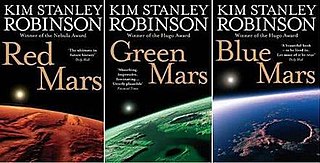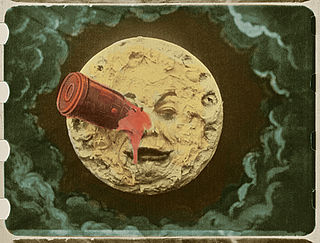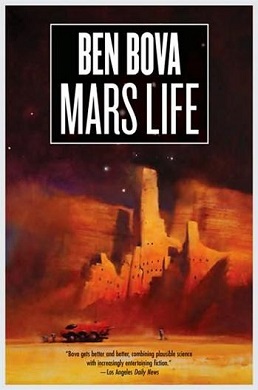
Mars, the fourth planet from the Sun, has appeared as a setting in works of fiction since at least the mid-1600s. Trends in the planet's portrayal have largely been influenced by advances in planetary science. It became the most popular celestial object in fiction in the late 1800s, when it became clear that there was no life on the Moon. The predominant genre depicting Mars at the time was utopian fiction. Around the same time, the mistaken belief that there are canals on Mars emerged and made its way into fiction, popularized by Percival Lowell's speculations of an ancient civilization having constructed them. The War of the Worlds, H. G. Wells's novel about an alien invasion of Earth by sinister Martians, was published in 1897 and went on to have a major influence on the science fiction genre.

The Mars trilogy is a series of science fiction novels by Kim Stanley Robinson that chronicles the settlement and terraforming of the planet Mars through the personal and detailed viewpoints of a wide variety of characters spanning almost two centuries. Ultimately more utopian than dystopian, the story focuses on egalitarian, sociological, and scientific advances made on Mars, while Earth suffers from overpopulation and ecological disaster.

Andromeda: A Space-Age Tale is a science fiction novel by the Soviet writer and paleontologist Ivan Yefremov, written in 1955–1956 and published in 1957. It was translated into English as Andromeda: A Space-Age Tale by George Hanna. The novel predicted some future inventions. The German translation of the novel which was highly censored was serialized in the East German popular science magazine Jugend und Technik in 1958. It was made into a film in 1967, The Andromeda Nebula.

The Moon has appeared in fiction as a setting since at least classical antiquity. Throughout most of literary history, a significant portion of works depicting lunar voyages has been satirical in nature. From the late 1800s onwards, science fiction has successively focused largely on the themes of life on the Moon, first Moon landings, and lunar colonization.

Voyage is a 1996 hard science fiction novel by British author Stephen Baxter. The book depicts a crewed mission to Mars as it might have been in another timeline, one where John F. Kennedy survived the assassination attempt on him on 22 November 1963. Voyage won a Sidewise Award for Alternate History, and was nominated for the Arthur C. Clarke Award in 1997.
The Grand Tour is a series of novels written by American science fiction author Ben Bova.

The Martian Chronicles is a 1980 television three-episode miniseries based on Ray Bradbury's 1950 book The Martian Chronicles and dealing with the exploration of Mars and the inhabitants there. The series starred Rock Hudson, Darren McGavin, Bernadette Peters, Roddy McDowall, Fritz Weaver, Barry Morse, and Maria Schell. It was aired on NBC in January 1980 in three episodes with a total running time of just over four hours. The series depicts Mars as having a "thin atmosphere" which humans can breathe, with water-filled canals and desert-like vegetation. The miniseries was directed by Michael Anderson and written by Richard Matheson.
Hugh Walters was a British writer of juvenile science fiction novels from Bradley in the West Midlands region of the United Kingdom.

The idea of sending humans to Mars has been the subject of aerospace engineering and scientific studies since the late 1940s as part of the broader exploration of Mars. Long-term proposals have included sending settlers and terraforming the planet. Proposals for human missions to Mars have come from agencies such as NASA, CNSA, the European Space Agency, Boeing, and SpaceX. As of 2023, only robotic landers and rovers have been on Mars. The farthest humans have been beyond Earth is the Moon, under the Apollo program.

Flight to Mars is a 1951 American Cinecolor science fiction film drama, produced by Walter Mirisch for Monogram Pictures, directed by Lesley Selander, that stars Marguerite Chapman, Cameron Mitchell, and Arthur Franz.

Mars to Stay missions propose astronauts sent to Mars for the first time should intend to stay. Unused emergency return vehicles would be recycled into settlement construction as soon as the habitability of Mars becomes evident to the initial pioneers. Mars to Stay missions are advocated both to reduce cost and to ensure permanent settlement of Mars. Among many notable Mars to Stay advocates, former Apollo astronaut Buzz Aldrin has been particularly outspoken, suggesting in numerous forums "Forget the Moon, Let’s Head to Mars!" and, in June 2013, Aldrin promoted a crewed mission "to homestead Mars and become a two-planet species". In August 2015, Aldrin, in association with the Florida Institute of Technology, presented a "master plan", for NASA consideration, for astronauts, with a "tour of duty of ten years", to colonize Mars before the year 2040. The Mars Underground, Mars Homestead Project / Mars Foundation, Mars One, and Mars Artists Community advocacy groups and business organizations have also adopted Mars to Stay policy initiatives.

Mars Life is a science fiction novel by Ben Bova. This novel is part of the Grand Tour series of novels. It was first published in 2008 and is a sequel to Ben Bova's novel Return to Mars.

Nebo Zovyot is a 1959 Soviet science fiction film directed by Aleksandr Kozyr and Mikhail Karyukov. It was filmed at Dovzhenko Film Studios in 1959 and premiered September 12, 1959.

Mars is a hard science-fiction television series produced by National Geographic that premiered on November 14, 2016, on its channel and FX. Prior to its official airdate, it was launched in a streaming format on November 1, 2016. It blends elements of real interviews with a fictional story of a group of astronauts as they land on the planet Mars.

Mission Mars is a 1967 American science fiction film. It was produced by Everett Rosenthal, with a screenplay by Mike St. Clair from a story by Aubrey Wisberg, and directed by Nick Webster.
Missions is a French science-fiction television series first broadcast in 2017. Set in the near future, it depicts a mission to the planet Mars.

Project Mars: A Technical Tale is a 2006 science fiction novel by German-American rocket physicist, Wernher von Braun (1912–1977), credited as Dr. Wernher von Braun. It was written by von Braun in German in 1949 and entitled Marsprojekt. Henry J. White (1892–1962) translated the book into English and it was published later by Apogee Books (Canada) in 2006 as Project Mars: A Technical Tale, almost thirty years after von Braun's death. The original German text remains unpublished.














